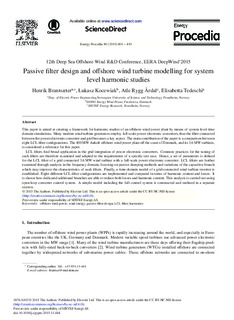| dc.contributor.author | Brantsæter, Henrik | |
| dc.contributor.author | Kocewiak, Łukasz | |
| dc.contributor.author | Tedeschi, Elisabetta | |
| dc.contributor.author | Årdal, Atle Rygg | |
| dc.date.accessioned | 2016-02-03T12:21:54Z | |
| dc.date.accessioned | 2016-03-10T14:49:21Z | |
| dc.date.available | 2016-02-03T12:21:54Z | |
| dc.date.available | 2016-03-10T14:49:21Z | |
| dc.date.issued | 2015 | |
| dc.identifier.citation | Energy Procedia 2015:401-410 | nb_NO |
| dc.identifier.issn | 1876-6102 | |
| dc.identifier.uri | http://hdl.handle.net/11250/2381992 | |
| dc.description.abstract | This paper is aimed at creating a framework for harmonic studies of an offshore wind power plant by means of system level time
domain simulations. Many modern wind turbine generators employ full-scale power electronic converters, thus the filter connected
between the power electronic converter and grid becomes a key aspect. The main contribution of the paper is a comparison between
eight LCL-filter configurations. The 400 MW Anholt offshore wind power plant offthe coast of Denmark, and its 3.6 MW turbines,
is considered a reference for this paper.
LCL filters find broad application in the grid integration of power electronic converters. Common practices for the tuning of
such filters are therefore examined and adapted to the requirements of a specific test case. Hence, a set of parameters is defined
for the LCL filter of a grid connected 3.6 MW wind turbine with a full-scale power electronic converter. LCL filters are further
examined through analysis in the frequency domain, focusing on passive damping methods and variations of the capacitive branch
which may improve the characteristics of such filters. Finally, a time-domain model of a grid-connected wind turbine inverter is
established. Eight different LCL-filter configurations are implemented and compared in terms of harmonic content and losses. It
is shown how dedicated additional branches are able to reduce both losses and harmonic content. This analysis is carried out using
open-loop converter control system. A simple model including the full control system is constructed and outlined in a separate
section. | nb_NO |
| dc.language.iso | eng | nb_NO |
| dc.publisher | Elsevier | nb_NO |
| dc.title | Passive Filter Design and Offshore Wind Turbine Modelling for System Level Harmonic Studies | nb_NO |
| dc.type | Peer reviewed | nb_NO |
| dc.type | Journal article | en_GB |
| dc.date.updated | 2016-02-03T12:21:54Z | |
| dc.source.journal | Energy Procedia | nb_NO |
| dc.identifier.doi | 10.1016/j.egypro.2015.11.444 | |
| dc.identifier.cristin | 1299141 | |
| dc.description.localcode | © 2016 The Authors. Published by Elsevier Ltd. This is an open access article under the CC BY-NC-ND license. | nb_NO |
